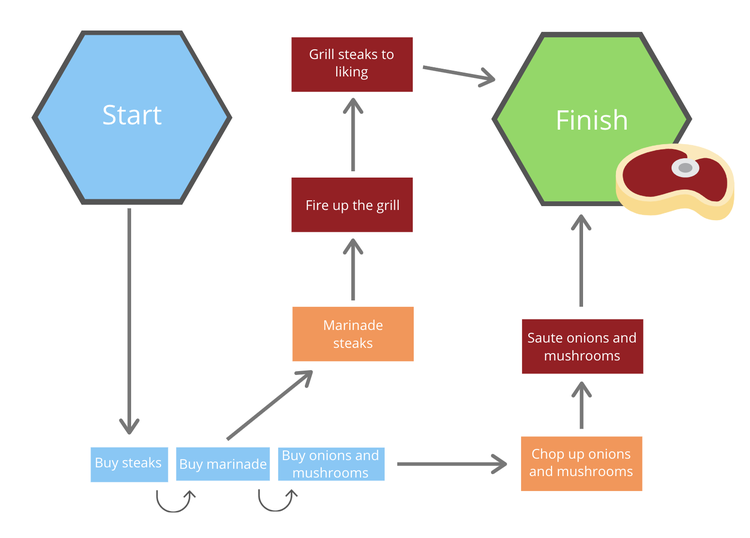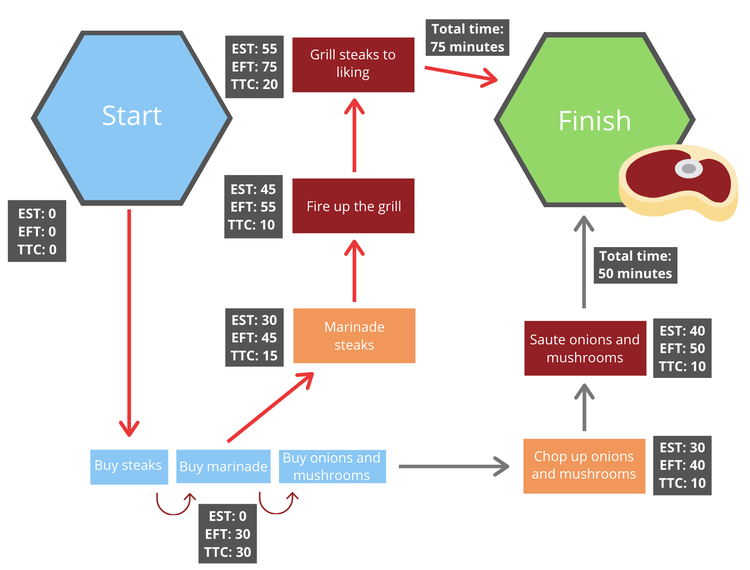Creating a project schedule is no easy task, but while you map out your project schedule, you obviously need a project duration estimate, including proposed time spent on tasks, milestones, and estimated completion times.
It’s time we pivot from the project management basics and into something far more specific. This is where critical path methodology comes into play.
Overview: What is the critical path method?
In the simplest terms, the critical path method is the evaluation and identification of the critical steps necessary in order to determine the duration of a project.
This method is a very well-known and established project management technique, originating in the 1950s as a solution to project delays with the U.S. Navy’s ballistic missile program.
However, instead of dealing with ballistic missiles, let’s look at a simplified critical path for grilling a steak:

Here I’ve laid out the critical and non-critical tasks for grilling a steak. Image source: Author
Notice that there are critical and non-critical tasks for grilling up a steak. The tasks in red lay out the necessary steps for cooking a steak, while the tasks in blue are optional tasks that will turn your steak from good to great.
You can cook a steak without the blue tasks, but you can’t ever hope to cook a steak without the red tasks.
Important critical path terms
Before we go any further, there are a few relevant terms you need to know. These are the most common project management terms used in the context of critical path analysis, some of which I will use later in my guide.
- Earliest start date: The earliest date in which you can start a particular task in your project. In order to determine this date, you must first know which other tasks are dependent on this one.
- Earliest finish date: The earliest date a task will be completed. This is calculated by adding up the previous step times until you reach the step you are attempting to measure.
- Latest start date: The latest date you can begin a task before it will impact the rest of your project schedule.
- Float (aka slack): The length of time a task can be delayed before it impacts the project schedule. Tasks on your critical path will not have any float, while tasks that do have float are deemed “non-critical.”
- Crashing: Allocating additional resources to a particular task in order to move up the completion date. This should only be done when absolutely necessary with resources only pulled from tasks with a higher float so as not to impact the critical path.
- Fast-tracking: Running multiple tasks or activities simultaneously with the aim of reducing the overall scheduled project time.
How to find the critical path for your project
When I first learned about the critical path method years ago from an old friend, it took me a few explanations to fully understand the concept. She is a project management wizard, but sometimes she would lean on “insider baseball” terms to describe the process.
That’s why I’ve decided to stick with the steak example for the sake of simplicity.
Here is a four-step beginner’s guide for finding the critical path of your project.
Step 1: List out all of the project tasks
Using a work breakdown structure (WBS), you will need to identify all of the necessary tasks to complete the project. Your work breakdown structure is a visual representation of your project that literally breaks down your project into manageable sections.
Getting back to my steak-grilling example, the WBS might look something like this:

Grilling a steak is comprised of three milestones and eight basic steps. Image source: Author
Can you tell I’m a little bit hungry? When creating your WBS, make sure you don’t get too in the weeds with your subtasks, otherwise, your critical path will turn into a critical mess of complication.
Step 2: Establish task dependencies
Now that you’ve listed your tasks, it’s time to find out which tasks are dependent on each other and use that order of events to create a critical path analysis chart.
Since the steak example has worked well so far, let’s keep it going for continuity’s sake.

Since prepping and cooking steaks and vegetables are two separate processes, each receives its own pathway. Image source: Author
This chart will help you map out the critical path for completing a project, as well as show the additional non-critical steps you’ll have to take. However, before we determine the critical path, we have to establish the duration of these tasks.
Step 3: Determine the duration of each of these tasks
Here is where more of our critical path terms come into play, particularly “earliest finish date” and “earliest start date.”
The only difference for my example, we’re gonna go with “time” rather than “date” since it shouldn’t take days to grill steaks, obviously. This is a very crucial step because these durations we will measure will help us find our critical path for completing the project.
Using the previous critical analysis path chart, we are going to map out each of these times:

Now that we’ve mapped out the pathways, we can establish the duration of each pathway. Image source: Author
In this example, EST stands for the earliest start time, EFT is the earliest finish time, and TTC is the time to complete each task. I measured the time in minutes and calculated out the duration of each path for grilling some very delicious steaks.
Step 4: Identify the critical path
Now that we understand the duration of each path, we can identify which one is the critical path. As we established before, the critical path of a project is the measurement of the duration of the project, so this means that the longest path in the chart will be our critical path.
As an example, I’ve outlined the critical path on my chart in red:

The longest pathway is deemed the critical path with other subsequent paths marked as “non-critical.” Image source: Author
As you can see, it takes longer to prep and grill the steaks than it does to prep and saute the onions and mushrooms. Therefore the critical path for completing this meal is the steak route. Extras like onions and mushrooms have a decent amount of “float” since their preparation time is shorter and isn’t as necessary to the core goal.
What this means for you is if you find yourself falling behind with the steaks, you can allocate some of the extra time and resources from the onions and mushrooms (aka crashing) to ensure the meat is finished on-time.
Of course, we established the common sense critical path at the beginning of this piece (since most of us know how to grill a steak), but now we have numerical proof of a critical path in the process.
This is a simplified example of the critical path method, but you can easily extrapolate on this formula for nearly any project from home building to software development.
Now that you’ve mapped out your critical path, it’s time to get to work on adding this piece of information to your project management plan so you can get to work on cranking out your deliverables as soon as possible.
Can you monitor your critical path with project management software?
Yes. In fact, this is one of the best uses for Gantt timeline charts in project management software. Using Gantt charts, time tracking, task dependencies, and due dates you can use CPM scheduling to determine the duration of your project.
Some of my favorite project management tools with these features include:
Each of these tools includes Gantt charts, task dependencies, and in the case of Freedcamp, a critical path toggle that’ll show and hide a project’s critical path (CP) at the click of a button. I’d highly recommend conducting your critical path analysis within a project management software if for no other reason than to ensure accuracy.
Critical path method doesn’t work in a bubble
The critical path method is reliant on your understanding of a project, including what resources it will take to complete, what your schedule looks like already, and the risks associated with a project.
Luckily, we’ve written other project management guides at The Ascent that’ll help you piece together the information you’ll need to find the critical path for your project:
Our Small Business Expert
We're firm believers in the Golden Rule, which is why editorial opinions are ours alone and have not been previously reviewed, approved, or endorsed by included advertisers. The Ascent does not cover all offers on the market. Editorial content from The Ascent is separate from The Motley Fool editorial content and is created by a different analyst team.